Ask.com and Bing are very anxious to prove the world they can beat Google. Even in minor things, like Image Search that Bing was enhancing constantly over last several month. Or in a Search Engine Jeopardy contest, managed by Stephen Wolfram. Well, it seems Google competitors still have some work to do, as the Search Industry leader was victorious once again.
The SE Jeopardy consisted of Jeopardy questions randomly selected form a database of around 200000 that were fed into the search queries of various engines. The developers then looked at the number of correct answers that appeared in the search results page and also at the number of correct answers that were included in the page that search engines presented as the top result.
The results were as follows:
Percentage of correct answers appearing somewhere on the first page: Google – 69%; Ask.com – 68%, Bing – 63%, Yandex – 62%, Blekko – 58%, Wikipedia – 23%.
Percentage of correct answers appearing in the top result of the page: Google – 66%; Bing – 65%, Yandex – 58%, Ask.com – 51%, Blekko – 40%, Wikipedia – 29%.
Obviously Wikipedia didn’t stand too much chance, as it was only one website competing against “the whole internet”. Still, it must be noted that only about one-third of Jeopardy answers are already in Wikipedia…
As to Search Engines – Google has beaten the competition, although the margins are not that big. But based on these results, Ask and Blekko have to do a better job of listing the most relevant link at the top (see how their percentage dropped when they looked into the first document. And Bing is “almost there” – but still a fraction behind Google.
Yandex numbers were very impressive, as it is basically a local Russian search engine. If the test has been done in Russian (or at least, based on Russian Jeoprdy Analogue, “Svoya Igra”, which includes fewer questions about American culture and history) Yandex would probably beat Google – exactly as it does in the Russian Search Engine market.
In summary, nobody can beat Google in providing relevant information. Not just yet. So, when you want to know “What is” something – don’t ask and don’t bing. Google it!
Google Webmaster Tools are a popular feature, servicing hundreds of thousands and maybe even millions of website owners and web analytics over the world. Everybody works with the provided numbers, without questioning the reliability of the data. However, ask a mechanical engineer – and he will tell you that everything in this world has a “tolerance” and no value is absolutely accurate.
The same mechanical engineer will tell you that usual general acceptable tolerance is about 1%, so when certain parts should be 10 inch, it can easily measure 10.1 inch or 9.99 inch – and will still pass the Quality Assurance test.
It seems, Google is not yet ready to go into Product Design. Reportedly, the numbers offered by Google Webmaster Tools are only 90% accurate. According to Google’s Asaph Zemach, who was asked about number of impressions staying constant for three months time: “…when you see 24,900,000 you should really think 25M+/- 2.5M…”
Thus, if you think that your website is ahead of competitors, with 50 million impressions compared to their 48 million, they might be already ahead of you, as your actual figure might be as low as 45 million and theirs – as high as 52 million… As usual, statistics can be deceiving – and Google’s +/-10% just makes it more so…
The marketing has always been about customer’s psychology – learning the specific needs of a potential client and trying to satisfy them. Google has demonstrated once again that targeting certain audience is mandatory. And if you are into SEO, you should be aware of it.
According to one recently published study, Google Search results on a smartphone will vary by over 80% from those produced by a desktop computer query. If you think about it – this is actually quite logical to have a slightly different search algorithm for smartphones. For example, smartphone users like downloading various applications. Thus the mobile Google Search presents many results that include the word “app” or “download”. Brand filters and store filters cannot be applied to mobile Google search and it is even more biased towards “local” domains, with Google places usually appearing higher in the vertical results list.
With the smartphone market growing quickly, it seems as only a matter of time when “SEO for mobile” will become a separate branch in the industry.
It’s no big news that Chinese market is growing with an impressive speed and more and more businesses turn eastwards – both for production and marketing. Over a billion people live inside the Far East giant borders – a healthy reason to address the region in order to increase sales as well as exposure.
The news is, however, that the internet content is now also part of the trend. China has reportedly surpassed USA in the number of internet users in mid-2009, and although English is still the primary internet language (42 percent of almost two billion of online “population” worldwide), Chinese is in solid second place, with about 32 percent. And since China is still less technologically advanced than the Western Countries, the number of potential Chinese speakers, who will soon be joining the online world is far greater than that of the English language carriers.
And with the Chinese government now requiring all English content in China-based websites to be accompanied with local Mandarin translation, the number of webpages in Chinese is about to increase immensely. And, restating the above thought about more and more companies regarding China as a prospective market, it seems that the near future of online marketing can easily shift toward Chinese content.
Our world, especially the online part of it, is all about speed. That’s why Google had become so popular so quickly. The amount of search results shown and the speed at which those result have been accumulated and presented to the user did the trick.
Nowadays, of course, many search engines are almost as quick as Google, the difference in speed of producing the search results measured in milliseconds. However, what the users now want from their SE is convenience and reliability. With several questions asked about Google supposedly “biased” results, the Search Engine giant’s UI had never been an issue. That is, until now. The revised Google Image Search has a problem that can reduce the speed of entering a query.
Normally, when you type the query term in the search box and get the results, you do not use your mouse. Continue typing for “narrowing” the search, or press Shift-Backspace to erase the previous entry and start over. So far so good. However, when you use Google Image Search, the query box seems to lose the mouse focus once the pointer is moved – deliberately, or accidentally. So, when you decide to alternate your search, you have to use the mouse (one of the worst nightmares of the speedy typer) in order to activate the query box again.
Google have reported they are aware of the problem and the “frustration” and “looking for ways” to solve it.
With Goggle introducing its new tool, the Google Books Ngram Viewer several days ago, many were enthusiastic about this being an ultimate feature to use in etymological research. After all, the Ngram Viewer allowed to search millions of books (Google books, of course) and then check, track, and analyze the appearances of any word throughout many centuries.
The users were enthusiastic at first, but it turned out that the tools is far from perfect. According to recent review, there are many problems and inaccuracies in Ngram Viewer reports – both expected and unexpected. A very basic issue is the OCR – Optical Character Recognition. Even for modern books and fonts, there are occasional mistakes that occur, best OCR programs report just below 1% percent error margin for a text of recognized words. For books from the 16th and 17th centuries, with the artistic fonts this margin is sure to be higher. One example is the letter “s” confused with “f” on numerous occasions.
Another problem observed is that for the first occurrence, as Google Books NGram Viewer does not take into account the developing of language over time, thus you have to research several forms of the world used throughout the centuries to find the actual first usage. And also, there are the reprints. Many Google books are labeled with the year of their print, instead of the year of the original manuscript, making the search produce more hits for “recent” years.
Overall, Google Books Ngram Viewer is not bad. It is just not as reliable as one could think it is. Suitable for occasional queries, it cannot be considered as reliable tool in serious academic research.
In the world of Web analysis the software title Piwik should be very attractive to those in the open-source sector. Piwik is an open-source Web analytics program (General Public License) that works in real time.
Key features include detailed reports about visitors to your Web sites as well as specific information on the keywords and search engines used to reach your location. You can also track data related to most popular pages.
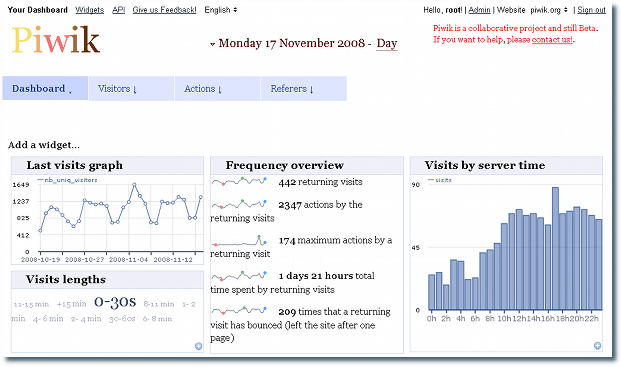
One of the nicest features about Piwik is that you can use it whether you speak English or not. In fact, the software is available in more than 30 languages already and the number is growing.
Interested individuals can try Piwik with an online demo. To install Piwik you only need to download the latest release, upload to your Web server and open your browser. *PHP 5.1 and a MySQL database are required. Installation will take about five minutes and should be automatic. It can be downloaded from the Web site as “an open-source alternative to Google Analytics,” according to www.piwik.org. The download provides a JavaScript tag that can be copied and pasted on Web sites you would like to track.
What’s in Piwik
It’s easier to describe what is not included in Piwik 1.0 than it is to list all the tools and features available. Think of this as a very complete analytics program that “won’t provide advanced web analytics features that can be found in other commercial products: custom report generator, custom segments and real time segmentation, funnel analysis, advanced ecommerce reporting, etc. Some of these features could be built in plug-ins, but require significant effort and challenge to make them work with high traffic websites. We are building an open web analytics framework that people will use to later add these advanced features.” (Piwik Web site)
The Piwik team emphasizes that if a developer builds a feature that is not included already team members will “definitely work with him/her to integrate the feature in Piwik!”
Marketing information from the Piwik folks states that the real-time analytics reports help separate this software from the competition. Report frequency can be selected for high-traffic Web sites. New features can be added and unneeded features can be removed, primarily because Piwik features are “built inside plug-ins.” Developers can build their own analytics plug-ins with ease. According to plan, Piwik is installed on the users own server. “You can get all the statistics using open APIs (publishing the data in may formats: xml, json, php, csv).
The user interface can be customized, with reports fine-tuned to individual use. You can view your activity with a last-visits graph that shows the highs, lows and baseline numbers you need to understand how your sites are working. View a list o external Web sites with associated information such as visits, unique visitors and action per visit. Follow your visitors with a chart that shows browser use by family and with a map showing country of origin. Of course, the keyword list by number is essential information displayed in the easy-to-read user interface.
Inside Information
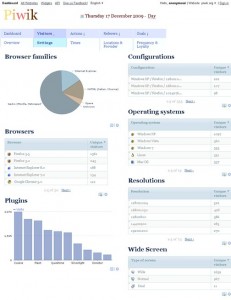 We mentioned earlier that PHP 5.1 and a MySQL database are required for download and use. PHP (Hypertext Preprocessor) is a general-purpose scripting language designed for Web development, with the goal of producing dynamic Web pages. (Wikipedia) PHP performs operating-system tasks and may also work as a graphical application.
We mentioned earlier that PHP 5.1 and a MySQL database are required for download and use. PHP (Hypertext Preprocessor) is a general-purpose scripting language designed for Web development, with the goal of producing dynamic Web pages. (Wikipedia) PHP performs operating-system tasks and may also work as a graphical application.
The MYSQL database is recognized as the world’s most popular open source database because of its consistent fast performance, high reliability and ease of use.” (www.mysql.com) MySQL is the database of choice for numerous applications and runs on “more than 20 platforms.”
This type of foundation allows Piwik to be implemented with relative ease when you want to track Web activity with accuracy. As the Piwik team has stated, the project started with a goal of producing a “solid Web analytics product.” But the individuals took the process a step further and focused on “a great user experience.” It seems they have hit the mark, as users report a painless installation process, a good interface design and reports that first-time users will be able to understand right away.
In the effort to encourage “an active community” Piwik has focused on documentation for users and developers, strong forums and plug-in construction so that developers can “customize Piwik, record new custom data or access new reports.” The Web site sends out a call for people who are interested in translations or beta testing. Developers are directed to the “developer zone” to find out how to build Piwik plug-ins.
Developer documentation includes:
Perhaps the most important factor separating Piwik from Google Analytics is the open-source foundation. Google Analytics started out with proprietary technology that often tailored reports and data to those who use other Google services. Piwik was introduced in France and has gradually built a large following (30 languages)!! Even if other Web analysis software is free, Piwik stands a better-than-average chance of gaining an even larger foothold in the Web-business world.
Piwik is open source analytics for the user and the developer. I would image that the entire search engine optimization community would be very interested in a strong alternative to Google Analytics that is free.

Paying for irrelevant clicks in your pay per click (PPC) ad campaign is frustrating, but is there anything you can do to minimize the chances of this happening? Yes, in fact. Three of the biggies are the use of negative keywords, exact match, phrase match, and broad match.
Negative keywords have a major impact on your click-through rate (CTR) and therefore, your campaign’s return on investment (ROI). When you use the “phrase match” and “broad match” options setting up your AdWords campaigns, you should include negative keywords as well. It’s easy to do. Go to your AdWords account and click on the “Keywords” tab. You have the option of adding new keywords, as you can see in the screen shot. Notice at the bottom of the screen shot, how you can designate keywords as:
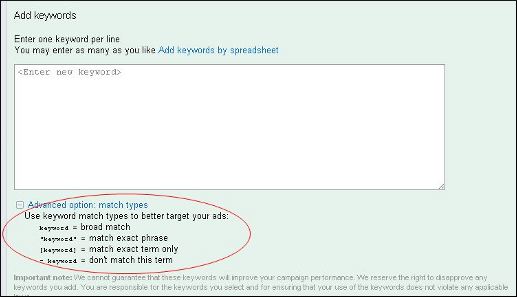
Setting up negative keywords by placing a minus sign in front of them lets you filter out identical terms that can have very different meanings. For example, suppose you sell photographs of foxes (Work with me here, OK?). Well, if someone searches on fox photos thinking they’re going to get pictures from The Simpsons on Fox television network, you’ll be paying for their irrelevant clicks. Therefore, you want to use negative keywords like “television” and “network” to limit the number of times an ad for your photographs of foxes appears on a page when someone wants pictures from the TV network.
Judicious use of negative keywords can help improve the quality score of your keywords. A number of factors influence your keywords’ quality scores, including its general performance. Bottom line: a higher quality score makes your keyword trigger ads at a lower cost per click and positioned higher. Your CTR is the most important aspect of your quality score. A lot of “accidental” clicks on your ads can lower your click through rate. By using negative keywords, you’ll have fewer ad impressions, but fewer “false positive” clicks on your ads.
Finding the right negative keywords is a very important parts of a PPC campaign, but it can be complicated. One way to select negative keywords is to use your regular keyword research. The Google Keyword Tool will show you the keyword phrases that are more relevant and less relevant to your products and services. But relevance doesn’t always mean they match the searcher’s intent, and that’s what negative keywords help you with.
You’re not charged for negative keywords, and there isn’t a penalty for having a long list of negative keywords, so it’s worth your while to do some hard core keyword research and compile a list of negative keywords. You can have up to 10,000 negative keywords per campaign, so you’re not likely to use them all up. (Yahoo lets you have 250 negative key words and phrases, and Microsoft AdCenter limits you to 1024 characters worth of negative key words and phrases.)
Google’s Keyword Tool isn’t the only place that can help you come up with negative keywords. You can use server log files to find info on queries that lead people to your site. Heck, you can even use a thesaurus if that helps. Sometimes common sense helps you think up good negative keywords. Suppose, for example, your products and / or services are only available in certain geographic areas. You can use names of places your stuff isn’t available as negative keywords. For example, if you paint houses in Portland Maine, you don’t want to be paying for the clicks you might get from people in Portland, Oregon. Therefore, you can use “Oregon” as a negative keyword to keep out some irrelevant clicks. So the takeaway from this is that even though negative keywords will cause you to have fewer ad impressions, the CTR and quality score will go up, and so will your return on investment.
It’s exactly what it sounds like. If you want your ad to show up when someone searches on “baseball caps” but not on just baseball or just caps, then you specify your keyword in brackets when you choose your AdWords keywords: [baseball caps]
If you choose [baseball caps], your ads might show up when someone searches for baseball caps, but it will not show on searches like “baseball cap,” “blue baseball caps,” or “buy baseball caps.” Now, while this will cut down on the number of ad impressions, clicks, and conversions, those clicks you do get will likely be highly targeted toward your service.
Suppose that you chose “baseball caps” as one of your keyword phrases for your ad campaign. Your ad is eligible to show up on searches such as “buy baseball caps,” “baseball caps giveaway,” or “green baseball caps.” They will not show up on searches like “caps for baseball,” “baseball cap,” or “baseball hats.”
This is a more targeted approach than a plain broad match, but it’s more flexible than exact match ([baseball caps]).
Broad match is the default option. If you used the phrase baseball caps with no bracketing, no quotation marks, no negative sign, your ad could show up on searches for “baseball,” “caps,” “baseball hats,” or “caps for baseball.” You’ll get more click throughs, but you’ll get more erroneous click throughs as well. Now it’s possible that someone will be searching the term “baseball” wanting to find certain statistics, click on your ad, and be smitten with it enough to buy one of your baseball caps.
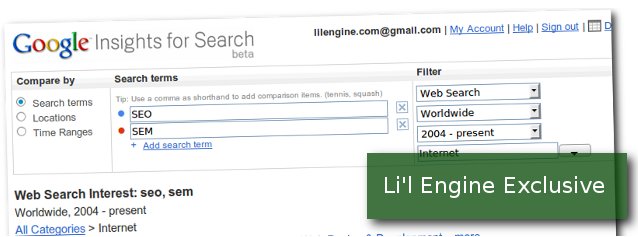
In August 2008 Google launched its tool called Google Insights for Search. It’s like Google Trends on steroids. There are many new features designed with advertisers and marketing professionals in mind to help them (and anyone else who is interested, such as the average website owner) understand search behavior.
Google Trends displays how frequently a search term is queried in relation to the total search volume throughout all regions of the world in different languages. Google Trends produces a graph where the horizontal axis shows a simple timeline (which goes back to 2004), and the vertical axis is how often a term gets searched for devided by the total number of searches worldwide. It also produces popularity broken down by location and language.
Google Insights is a more sophisticated tool to help people gauge interest in relevant search terms. For example, Google Insights can help you figure out which messages go over best. Suppose you make high-end espresso machines. You can use Google Insights to determine whether your advertising should highlight money savings over coffee shop coffee, taste test results, or performance and features. Google Insights can also be used to determine seasonal variations in search behavior and to help advertisers and marketing professionals create more effective brand associations.
As just a quick example, typing the search terms “espresso,” “home espresso machine,” and “gourmet coffee” in the category “Food & Drink” for 2009 yields the data you can see in the first screen shot. when you look at the graph of “Growth Relative to the Food & Drink Category” you can see that it takes a big jump in December that is most likely due to Christmas shopping. Looking at the terms by region, you can see that Greece, Netherlands, and Germany are the regions that searched most on “espresso.” The only blip at all for the term “gourmet coffee” comes from the United States, and it’s very small.
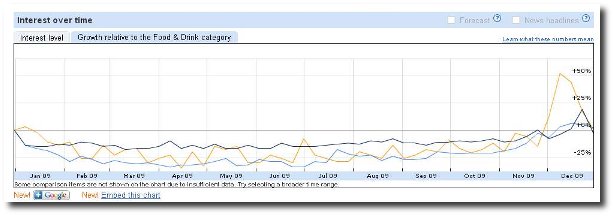
But you can also learn that the top three searches of related terms are “coffee espresso,” “espresso machine,” and “cafe espresso.” The top three rising searches are “espresso on line” (popular in Italy), “espresso apparaten” (tops in Netherlands), and “cowgirl espresso” (the most popular in the U.S.). With this information I could zero in on Greece, Italy, and Netherlands and try to get to the heart of the popularity of the search terms there.
You are not limited to Google web searches. You can also analyze results from Google News, Product Search, and Image Search. You can break the data down even further from there. For example, you could look at hot Google News searches over the past week, month, or quarter. Queries can be broken down by region into individual metropolitan areas. This is a tool that news journalists find helpful in gauging interest levels in different subjects among their readership base.
One researcher gauged the interest of the U.S. college basketball tournament known as “March Madness” for a period of one week during March 2009. The results showed that interest was highest in the states of Kentudky, Iowa, and Kansas. In 2010, journalists could gauge popularity of search terms related to the World Cup in South Africa in various regions around the world. In a nutshell, what Google Insights does is help anyone who is interested (webmaster, ad agency, small business owner, academic researcher, or otherwise interested party) measure interest in search terms relative to their particular area of research.
Suppose, for example, you have a seasonal business, perhaps a surf shop in Torquay, Australia. While you know that your peak business will occur in January through March, maybe you want to know when people start querying about surfing holidays in Australia. If you plug “surfing Australia” and “surfing holidays Australia,” you’ll discover that with the exception of 2004, there are peaks of interest at the beginning and end of each year as one might expect. This can be seen in the second screen shot.
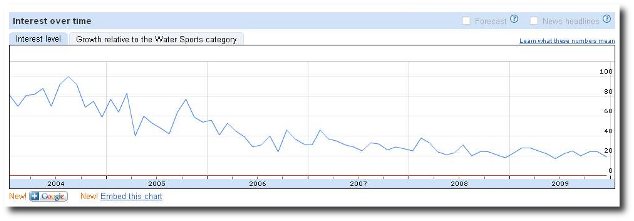 But scroll down further and you can see that the rising searches include “rip curl australia,” “asp surfing australia,” and “surfing in australia.” Further probing shows that Victoria is the state with the most searches, and Melbourne is the city with the most searches on “rip curl australia.” So as the theoretical owner of a Torquay surf shop, I may decide to pitch my advertising especially aggressively in Melbourne.
But scroll down further and you can see that the rising searches include “rip curl australia,” “asp surfing australia,” and “surfing in australia.” Further probing shows that Victoria is the state with the most searches, and Melbourne is the city with the most searches on “rip curl australia.” So as the theoretical owner of a Torquay surf shop, I may decide to pitch my advertising especially aggressively in Melbourne.
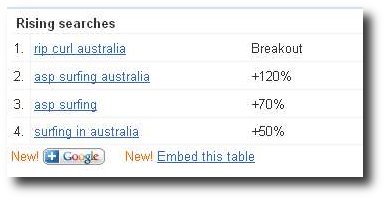 You can use Google Insights to flesh out keyword ideas and perhaps tweak any Adwords Campaigns you’re running. You can download the results to a spreadsheet for convenience. To download data to spreadsheets you will have to sign into your Google account. Google Insights is available in 39 languages, and will soon add a forecasting feature that will be available for some queries. An Animated map function will allow Google Insights users to see how interest changes with time and location.
You can use Google Insights to flesh out keyword ideas and perhaps tweak any Adwords Campaigns you’re running. You can download the results to a spreadsheet for convenience. To download data to spreadsheets you will have to sign into your Google account. Google Insights is available in 39 languages, and will soon add a forecasting feature that will be available for some queries. An Animated map function will allow Google Insights users to see how interest changes with time and location.
Google Insights is a flexible enough tool that users can think of countless ways to use it. Beyond just expanding your keyword lists or looking at economic trends, you can use it for things like satisfying your curiosity about why some other site ranks higher in the search engines than yours. Even historians of the post-2004 era will find a wealth of information about how search queries evolve over time and across world regions.
Small business owners, ad agencies, and marketing specialists can use Google Insights to compare brands in real time over real markets. If there is a clear indication that a particular ad campaign is working well in a particular region or city, they can more accurately target offline advertising and even promotional events. Research using Google Keyword Tool has shown that search volume estimates are reasonably accurate, particularly in terms of relative value. That means that you can have a healthy amount of trust in the results you get from using Google Insights.